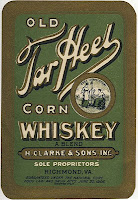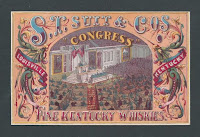 For almost 40 years Michael Stanton was a successful liquor merchant in a drinking man’s town -- Portsmouth, Ohio. Liquor had aided Portmouth’s growth along the Ohio River, whether it was the ration given to its workers on the Cleveland and Erie Canal or the hundreds of barrels of whiskey that reached the town via the canal. Most of the alcohol was loaded on boats but a significant amount was consumed in the dozens of saloons that lined Portsmouth streets.
For almost 40 years Michael Stanton was a successful liquor merchant in a drinking man’s town -- Portsmouth, Ohio. Liquor had aided Portmouth’s growth along the Ohio River, whether it was the ration given to its workers on the Cleveland and Erie Canal or the hundreds of barrels of whiskey that reached the town via the canal. Most of the alcohol was loaded on boats but a significant amount was consumed in the dozens of saloons that lined Portsmouth streets. Shown above in maturity, Stanton was born in Ireland in 1842 and came to the United States with his mother in 1846. His father had come the previous year. They settled in Junior Furnace, Ohio, a small town in Scioto County not far from Portsmouth. There Michael received his education. Coming of age just as the Civil War was starting, in 1862 he joined the Union Army as a messenger and was part of a cohort headed by Gen. Winfield Scott Hancock that fought up and down the Shenandoah Valley. At the war’s end he joined the largely ceremonial Veteran’s Corp headed by Hancock, later a Democratic Party candidate for President.
Returning to Ohio, Stanton’s early working years were spent toiling in local ore and coal mines and crewing on Ohio River boats. In 1870 he went to work in the liquor trade in Portsmouth, employed by G. W. Brown & Co. By the following year he had formed a partnership with James T. Bagby. They bought an established wholesale liquor house and operated it under their names. Eighteen months later Bagby departed and the firm became Stanton’s.
He became recognized as a leading citizen and businessman of Portmouth. He was a principal stockholder in the Portsmouth Wagon Stock Company. With partners he also was involved in land development in Southern Ohio. Moreover, in 1875 Stanton was elected to the Portsmouth City Council and served there with distinction. About the same time he married Mary Livingston, a native of Pennsylvania. They would have seven children, two of whom died in infancy.
Stanton would be remembered for his civic work, including being the chairman of the Finance Committee of the Council when street paving was accomplished. In 1893, according to his obituary, he played a major role in the community that was reeling from a recession, including darkened industries and major unemployment. Stanton, in effort to spur recovery, used his own credit among other resources to raise the money for municipal works projects. This and other efforts by Stanton, the Portsmouth Times asserted, assisted hundreds of the "needy and unfortunate."

His company name changed again when Michael found a new partner in S.P. (Simon) Balmert, a German immigrant. Together they created Stanton & Balmert, a wholesale liquor distribution business located at 161 and 163 West Front Street. With some 55 saloons in the vicinity of Portsmouth, a town of about 5,000, they found a ready customer base. Their brands included "Spring Lane Rye" and "Stanton’s Pure Rye and Whiskey." A large ceramic jug with the partners' names indicates whiskey for wholesale purchase

The partners quickly grew sales to more than $100,000 annually and became Portmouth’s largest liquor dealers. A clear flask from Stanton & Balmert displays prominently the company’s “S-B” monogram. The firm used the same symbol on shot glasses it issued, one for its 10-year-old sour mash whiskey and a second for its 10-year-old rye. A third, shown here, was an unusual green etched variant.


After operating successfully for 31 years, the company was brought short by Temperance forces. In 1908 legislation was passed in Ohio at the behest of the Anti-Saloon League that proved effective in harassing the drinking public. Called the Rose Law it established the right of “local option,” meaning that individual communities could ban drinking establishments. Portsmouth promptly did. That same year Balmert left to join another liquor establishment. Stanton went on alone as the M. Stanton Company, selling whiskey to nearby communities that remained “wet.”
About the same time Stanton was severely injured in a railroad accident that, according to his Times obituary, left him invalided for some months. After a period of slow decline and final weeks in a hospital he died in May 1909. The newspaper obituary said that Stanton was, "...The staunchest and most masterful advocate Portsmouth ever had...." It added that he was "a man to be admired and loved."

By 1911, it had become apparent to voters in Scioto County that simply abolishing saloons was not an effective solution to anything. Residents repealed the ban and made the swinging doors legal again. The firm Stanton founded was there to supply the whiskey. This victory was offset in 1913 by the Great Ohio Flood. Portsmouth’s Front Street, where the business was located, was inundated in nine feet of water, as shown here in a contemporary photo. Many people died and whole businesses were destroyed. Stanton’s company was among them and subsequently disappeared forever from city directories.
Despite the flood, Portsmouth continued to be a drinking man’s town. When statewide Prohibition was proclaimed in 1916, Portsmouth citizens formally marked the occasion by erecting a tombstone in the city square. Shown above, the monument declared: “In memory of a good town...Portsmouth died Sunday.” Several sprays of flowers were put a the foot of the tombstone, as well as beer bottles on its base and black crepe at its top. My hunch is that, had he lived, Michael Stanton might have been among its sponsors.






















.jpg)



















